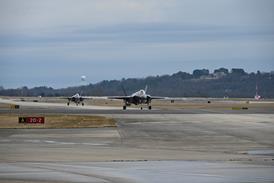The market for freighter conversions is estimated at some 2,300 aircraft in the next 20 years, but availability of appropriate aircraft for conversion may be an issue.
Speaking at Air Freight Asia, Bharat Bhise, president and chief executive officer of C-S Aviation Services, sees continued strong growth in the market for conversions where a successful conversion programme depends on economics, market demand, aircraft availability, programme management and strategic positioning.
Neil Hansford, chairman of Strategic Aviation Solutions, says conversion of ex-passenger aircraft to freighters can be viable if the aircraft has adequate annual utilisation, the sectors are long enough, it is written off over an appropriate period and the business that it is intended to carry can afford air carriage in the first place.
At Nippon Cargo Airlines, the experience of operating converted B747-200s alongside factory built B747-200Fs suggests there is no distinct advantage to either straight or converted freighters, says Hidenori Aritake, general manager international affairs.
However, at issue is the availability of appropriate aircraft of about 15 years of age.
In NCA's experience, used B747-200s "never came cheap," even at the height of the Asian economic crisis. In the event, all NCA's converted aircraft came from its affiliate Al Nippon Airways.
Shortage
NCA's Aritake is resigned to facing a period of supply shortage.
His experience also puts to rest two common criticisms of converted B747s. Weight restrictions of 200-300kg per pallet were not an issue; this never gave problems in actual payload terms.
As for the side door versus nose loading issue, Aritake could count on one hand the number of times per year that NCA lost a shipment because it could not be loaded through a side door.
On the contrary, he adds that the nose door itself causes some problems with ramp handling, especially on multi-stop routes.
Hansford, tracing the history of conversions, points to a shift toward converting widebody aircraft. He says a converted freighter makes good business sense only if it can satisfy a number of criteria.
Basing his calculations on the A300 84, Hansford says ; "Generally the passenger aircraft was manufactured in the early 1980 and has 60,000 hours on the airframe and 30,000 cycles. It is therefore 18 years approximately into its design life cycle.
"This type of aircraft would be acquired for $5-6 million and the freighter conversion and D check would cost around $6 million plus a further $1.5 million for engine reliability and extension enhancements.
"This gives an aircraft now costing around $14million, free from a major check for 24 months.
"A comparable new aircraft, could be expected to cost $70-80 million and give little or no benefits."
Burden
This asset, he says, must be utilised for at least 2,000 hours per year to make economic sense. Furthermore, it should be used on two to three-hour cycles to lessen the burden of engine overhaul.
Hansford says the ideal age for conversion would be around 15 years. The asset should not then be written off over less than the period available to avoid driving up the hourly cost of operation and reducing overall conversion viability,
Bhise says 52% of the worldwide freighter fleet which in 1999 numbered 1,018 narrowbodies and 435 widebodies, is over 25 years old, creating a large market for replacements.
Candidates for conversion total 4,912 aircraft, of which 1,944 are models still in production, 1,667 are out of production, and 1,301 are out of production but unfavourable for conversion.
Key considerations, he says, are the previous owner of the aircraft and its history of maintenance, and the reliability and reputation of the company contracted to carry out the conversion.
Provision of a turnkey conversion and maintenance programme is an important consideration of many customers.
Source: Flight Daily News























